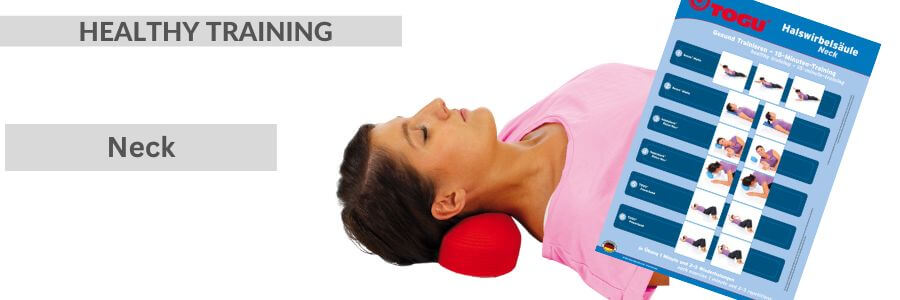What are the benefits of training the lumbar spine?
Lumbar spine training offers many benefits. A strong lumbar spine helps keep the body fit, prevent injuries and treat specific ailments. It is a valuable addition to a healthy and active lifestyle.
- Prevention of back pain: Building strength and flexibility in the lumbar spine strengthens the muscles that support the spine. This helps to better manage everyday stresses and prevent injuries.
- Improve posture and stability: targeted lumbar exercise helps develop an upright posture and a stable spine. Weak core muscles can lead to excessive stress on the lumbar spine, while a strengthened lumbar spine leads to improved posture and stability.
- Increase strength and flexibility: Specific exercises strengthen and stretch the muscles of the lumbar spine. This improves performance in everyday activities, promotes flexibility and can support athletic performance.
- Prevention and treatment of back pain: For people already struggling with low back pain or other back problems, lumbar spine exercise can be an effective method of prevention and relief. By building strength and stability, it takes pressure off the lumbar spine and can help prevent low back pain.
How can exercise help with a herniated disc of the lumbar spine?
Exercising can help with a herniated lumbar spine (LS) disc by having a number of positive effects on the body. Although a herniated disc is a serious condition, targeted exercise of the lumbar spine can play an important role in prevention, treatment and rehabilitation.
A herniated disc occurs when the inner, gel-like core of a disc ruptures through the outer fibrous ring and presses on adjacent nerves. This can cause severe pain, numbness, tingling or muscle weakness in the legs. Exercising the lumbar spine can help in the following ways:
- Strengthening the surrounding muscles: targeted exercise strengthens the muscles around the lumbar spine. Well-developed and strong muscles can support and relieve pressure on the spine by absorbing some of the load that would normally be placed on the discs. Stronger muscles can thus help stabilize the spine and reduce pressure on the affected disc.
- Improving posture and movement patterns: a herniated disc can lead to changes in posture and movement patterns as people try to avoid pain. Exercising the lumbar spine can promote proper movement patterns and healthy posture. This helps reduce stress on the discs and achieve better spinal alignment.
- Increase flexibility and range of motion: targeted lumbar spine training often includes exercises to improve flexibility and range of motion of the spine. Gentle stretching and mobilization of the lumbar spine can release adhesions, improve mobility and promote circulation. This can help support recovery from a herniated disc.
However, it is important that exercise for a herniated lumbar spine disc be done under the guidance of a medical specialist or physical therapist. Each case is unique, and training should be adjusted according to individual needs and abilities. Other treatment approaches such as rest, medication or physical therapy may also be required. Exercise should be considered as part of a comprehensive treatment plan to promote recovery and prevent relapse.
How can TOGU training devices support the training of the lumbar spine?
TOGU training equipment provides effective support when training the lumbar spine. The Powerball, Theragym Band and Ball Cushion are specifically designed to activate and strengthen the lumbar spine muscles. The ball pillow improves balance and posture, while the Powerball trains the hand and forearm muscles, which indirectly support the lumbar spine muscles. The Theragym Band allows various exercises to strengthen and stretch the lumbar spine muscles. TOGU training equipment thus offers a versatile and effective way to train and strengthen the lumbar spine.
Frequently asked questions about training the lumbar spine
How often should the lumbar spine strength training be performed?
It is recommended to perform lumbar spine strength training 2-3 times per week to allow sufficient stimulation and recovery time for the muscles.
Can lumbar spine strength training help with back pain?
Yes, targeted and properly performed lumbar spine strength training can help strengthen
What exercises should be avoided for lumbar spine disc herniation?
If you have a herniated disc of the lumbar spine, you should avoid exercises that put excessive stress or pressure on the spine, such as lifting heavy weights or jerky movements.
Can exercise put the disc back in place?
Exercise cannot directly put the disc back in place, but it can help strengthen the surrounding muscles and improve spinal stability, which can help relieve disc pressure.
How long does it take for a herniated lumbar disc to improve?
Improvement from a herniated lumbar spine disc can vary from individual to individual, depending on the severity of the herniation, treatment and commitment of the individual. In some cases, it can take weeks to months.
Should you exercise with pain?
For acute pain, it is advisable to pause exercise and seek advice from a specialist or physical therapist. For chronic pain, adapted training under professional guidance may be recommended.
Can lumbar spine training be performed after disc surgery?
After disc surgery, lumbar spine training should be individualized with a specialist or physical therapist to ensure that exercises are appropriate and support recovery.



















